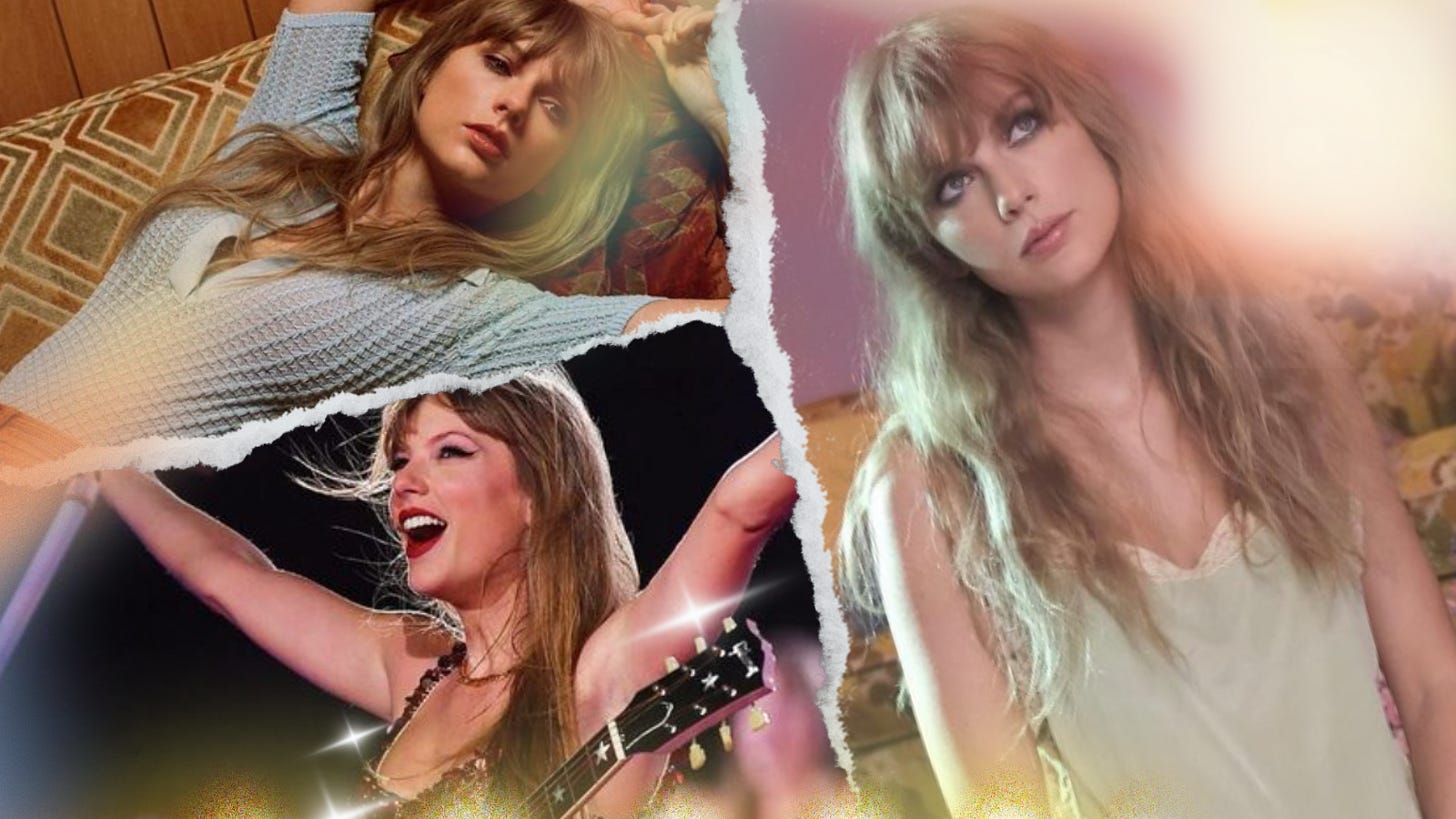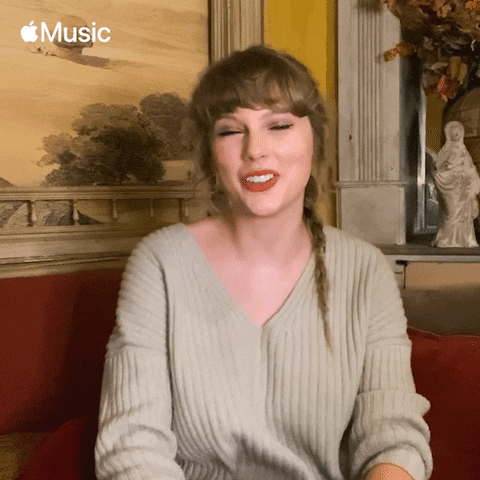How Taylor Swift Manufactures Intimacy
Swift sings about the world refracted through her lens, yet her stories maintain a universal appeal.
Two weeks ago, I got a video message from Taylor Swift.
Swift, who needs no introduction at the time of publishing, was dressed in her iconic Eras Tour Lover’s body suit and presumably backstage right before a show. “Oh hi, this is a special message from me to you, basically a thank you note.” Swift waved and then thanked me for listening to her music and having her on my Spotify Wrapped for 2023.
While Swift sent this video message to millions of Swifties who streamed her music until she became Spotify’s Top Artist for 2023, I felt that this message was mine. After all, Swift accompanied me across countless walks in the park, car rides, and midnights for over a decade.
Despite her pop juggernaut status and recent induction into the billionaire’s list, Swift manages to preserve the same accessibility that catapulted her to stardom as the nerdy girl next door pining over the high school quarterback from her bedroom. Perhaps it’s because she churns out hit after hit after hit about everyday heartbreaks, such as in All Too Well and Back To December. Or, perhaps it’s because she critiques her celebrity in the singles Anti-Hero and Look What You Made Me Do, grounding her persona.
Whether she’s singing about sleepovers with her BFF Abigail or her feud with Kanye West and Kim Kardashian, Swift rounds up support from Swifties and turns the narrative (some she doesn’t even want to be a part of) in her favor. So, how does the mastermind pull everything off?
Parasocial Relationships
I know too much about Taylor Swift. She was born on December 13 1989 in West Reading, Pennsylvania to Scott and Andrea Swift, who worked in the finance industry, and has one younger brother, Austin. When she was a teen, her parents moved the family to Nashville, Tennessee so she could pursue a country music career. She signed with Big Machine Records at age 14 and released her eponymous debut album at seventeen. She went on to release ten more studio albums over sixteen years. Swift has three cats, Meredith, Olivia, and Benjamin Button. Her lucky number is thirteen. Her favorite working lyricists are Fall Out Boy’s Pete Wentz and Lana Del Rey.
As much as I’d love to regurgitate fun facts about Swift, I doubt she knows of my existence beyond being one of the millions of data points in her Spotify analytics. If she even checks the numbers (she won’t even disclose how much money the Eras tour made so far). This one-sided nature of my Swift obsession positions our relationship — if we could even call it that — as parasocial.
Parasocial relationships involve two parties, where one party puts in time and emotional investment, while the other party is barely aware of the former’s existence. Examples of parasocial relationships include one a reader may have with a fictional character and, in our case, one a fan might have with a celebrity.
Opinions on parasocial relationships are divided. On one hand, critics argue that parasocial relationships provide a false sense of reality to the party investing in the relationship, which sometimes has dire consequences. The film Perfect Blue, directed by Satoshi Kon, explores the dark side of parasocial relationships where a fledgling Japanese idol falls victim to her stalker. A tragic real-world counterpart would be YouTuber and singer Christina Grimmie who was fatally shot by a stalker. Parasocial relationships breed delusion that could hurt the object of one’s infatuation.
On the other hand, supporters claim that parasocial relationships — when done healthily sans obsession — could help people in numerous ways. In their TIME Magazine article In Defense of Parasocial Relationships, writer Angela Haupt details that these relationships could help young people “form an identity and develop autonomy.” Parasocial relationships could also “offer a sense of companionship,” especially during prolonged periods of isolation, such as during the COVID-19 pandemic.
Regardless of our opinion on parasocial relationships, we must come to terms with their permanence in today’s cultural landscape. We now have an opportunity to dissect how public figures use parasocial relationships to fuel their reputation.
Accessible Lore
The most significant points of entry into the Taylorverse are Swift’s chart-topping, genre-defying discography. While most of Swift’s repertoire is composed of love songs delivered in her crisp storytelling, songs about fame, failure, and even politics crop up from time to time. Only The Young explores the power of youth activism and advocacy, especially during the 2016 US election cycle. The Man chronicles the sexism Swift faces in response to including aspects of her personal life in her music. Shake It Off is a celebratory up yours to all of her haters.
Swift sings about the world refracted through her lens, yet her stories maintain a universal appeal. Her songwriting incorporates intense emotions coupled with even the most mundane details of ordinary life. It’s the red scarf in All Too Well, the “three-hundred takeout coffees” in Is It Over Now?, and “every grocery store receipt” in marjorie that stops us in our tracks. In her TIME Magazine 100 speech in 2019, Swift mentioned Nora Ephron “everything is copy” aphorism as a guiding force in her songwriting practice.
We can’t talk about Swift without mentioning her much-publicized personal life. From her beef with Katy Perry to her romantic relationship with Jake Gyllenhaal to her Fourth of July celebrations with Gigi Hadid and the Haim sisters, what Swift does in her downtime suddenly becomes our business as well. Characterizing Swift as either a manipulator or an ingénue is tempting but disregards her mastery over her persona. In her TIME Magazine Person of the Year interview, Swift responds to the conversations and controversies surrounding everything she’s been doing all year round: “Are you not entertained?”
The Power of Digital Distribution
Swift’s physical presence fills stadiums by the tens of thousands and sends Swifties and paparazzi into rapid frenzies. Yet, we forget the small corners that Swift inhabits in our daily lives, through our computers’ built-in speakers, headphones, and, for a few of us, our friends’ humming. Now, we make acquaintances with pop stars who lurch toward our favorite cities through intimate moments in daily life. In her interview The Linguistic Phenomenon Behind Taylor Swift’s Superstardom, Georgetown professor and linguist Cynthia Gordon notes that this smartphone-enabled listening experience “creates a type of relationship that you feel that you develop with the artist as an individual.” The intimacy of listening to music on headphones coupled with Swift’s lucid personal storytelling heightens the closeness one feels toward Swift. Gone is Swift the superstar, and in comes Taylor, girl-next-door strumming on her guitar.
The amplification of Swift’s lyrical content through personal listening devices is what I believe drove her landmark re-recording project in 2021. Swift first expressed her plan to re-record all of her albums, save Lover at the time, in a 2019 interview, after she found out that Scooter Braun sold her masters without her consent. The singer-songwriter’s feud with Braun isn’t her first conflict over song royalties. In 2015, Swift took on Apple for not paying artists royalties for the three-month free trial of Apple Music. She published a statement on Tumblr, where a sizable chunk of her fandom lived online, on why she withheld 1989 on Apple Music. Although she notes in her message that earnings from her live performances are enough to support her and her team, I find her lack of overt self-interest hard to believe. Most Swifties — this one included — get sucked into the Taylor Swift Cinematic Universe by playing her songs in private, on repeat.
A childhood friend introduced me to Swift through the “Love Story” music video when I was nine years old. Soon, “Fearless” became the soundtrack of my childhood, playing constantly while waiting in traffic, writing essays, and daydreaming in my bedroom. I don’t know how many hours I clocked in from the ages of nine to twelve, but in 2023, I spent over 46,000 minutes — or, 31 days straight — listening to Taylor Swift. Adding fellow Swifties’ streams together, Taylor Swift’s royalties on Spotify for 2023 amount to 100 million dollars. The Eras Tour is estimated to earn over a billion dollars, but 100 million dollars is nothing to sneeze at. Besides, we wouldn’t be going to the Eras Tour if we didn’t stream her music in the first place.
We Speak Swiftie Now
Listening to Swift for hours on end imprints her lyrics in our brains. Then, we start quoting her in casual conversation and we find kindred spirits who also love quoting Swift. The acronyms, like yoyok, lwymmd, and atwtmvtvftvsgavralps pop up all over Instagram and Reddit. Suddenly, we’re speaking Swiftie.
Gordon describes this specific linguistic development as a “familect.” The term, a portmanteau of “family” and “dialect,” refers to a set of words and terms spoken within a close-knit group yet exists within a larger language.
What’s so intriguing about Swiftie-speak in particular is how Swifties address each other, instead of speaking directly to Taylor Swift. Inside jokes and special terms allow fellow Swifties to identify and bond with each other. I’ve heard “karma is my boyfriend” dropped in after recounting blunders with friends and acquaintances. Connecting with Swift through her music is the tip of the spear when it comes to cultivating intimacy at a global scale. We can’t talk to Swift directly, but we can find belonging with folks who share the same passions and interests as us.
Long Live Taylor Swift
This year, several institutions, including Harvard and Stanford, announced courses on Taylor Swift. The University of Melbourne will hold a three-day conference next February, the Swiftposium, to discuss Swift’s “impact on music, culture, and society.” For me, academia’s interest in Swift comes as no surprise. Swift’s songwriting, career, and persona are case studies in mobilizing community through intimacy and vulnerability. Through Swift, we learn how to embrace the cringe, the saccharine, and the excruciatingly personal — all with a devil-may-care approach earned through riding the rollercoaster of celebrity.
I could go on and on about Swift, but she isn’t the only celebrity who leans into parasocial relationships. BTS holds power through their ARMY and BLACKPINK finds support in their BLINKS. Let’s not forget when Selena Gomez and Hailey Bieber stans clashed on Instagram over the summer. These public figures not only provide endless entertainment to fill the humdrum of our lives but also show the awesome and terrifying results when people come together.
Most importantly, manufactured intimacy reveals just how much the general population craves connection right now. To put things into perspective, we’re gathering around celebrities in a quasi-religious experience that inspires almost cultish loyalty. We turn to idols instead of our neighbors just to feel something. I don’t know if we’re in a new era of radically different socialization, or if we’re so lonely that we get intimacy off the shelf.
hbd taylor swift !








Perfect Blue is one of my favorite animated films. I wish there were more Satoshi Kon films. He is missed.